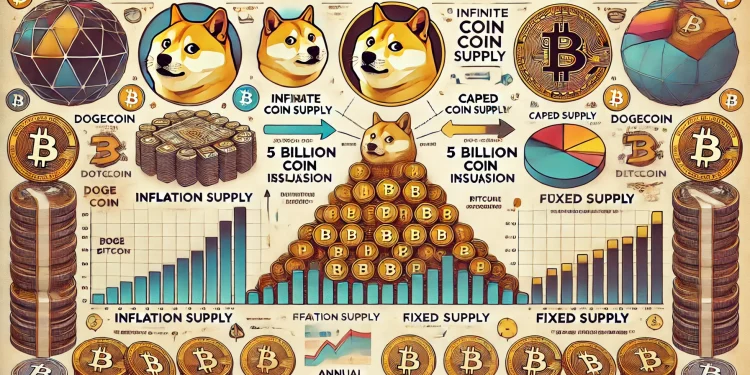Ethereum is at the heart of the non-fungible token (NFT) revolution, providing the critical infrastructure needed for the minting, trading, and management of NFTs. NFTs have transformed various industries, including art, gaming, fashion, and music, by allowing digital ownership, provenance tracking, and monetization opportunities. While many blockchains now offer NFT support, Ethereum remains the dominant player, powering a significant portion of the ecosystem. In this article, we explore how Ethereum’s technology drives the NFT market, its benefits and limitations, and the innovations shaping the future of NFTs.
1. What Makes Ethereum Ideal for NFTs?
Ethereum’s smart contract functionality is what sets it apart from other blockchains and makes it ideally suited for NFTs. A smart contract is a piece of code that runs automatically on the blockchain when predefined conditions are met. For NFTs, smart contracts manage the creation (minting), transfer, and ownership of digital assets.
The ERC-721 standard—introduced in 2018—paved the way for NFTs by ensuring that each token on Ethereum could represent a unique, indivisible asset. This contrasts with fungible tokens like Ethereum’s native currency (ETH), which are identical and interchangeable. Furthermore, the more recent ERC-1155 standard allows for the efficient management of both fungible and non-fungible tokens in a single contract, further enhancing Ethereum’s capability in the NFT space.
2. Ethereum’s Contribution to NFT Market Growth
Ethereum’s blockchain is the foundation for some of the largest NFT marketplaces, including OpenSea, Rarible, and Foundation. These platforms have allowed creators and collectors to mint, buy, sell, and trade NFTs with relative ease, driving mass adoption. Notably, Ethereum has also become the network of choice for major NFT projects, such as:
- Bored Ape Yacht Club (BAYC)
- CryptoPunks
- Art Blocks
- Axie Infinity
The growth of NFT art and gaming is tightly intertwined with Ethereum, as it facilitates seamless integration with decentralized applications (dApps) and wallets such as MetaMask.
3. Smart Contracts and Ownership on Ethereum
Smart contracts on Ethereum not only define the ownership of NFTs but also enable creators to program additional functionalities, such as:
- Royalties: Smart contracts can ensure creators receive a percentage of future sales whenever the NFT is resold, incentivizing long-term value creation.
- Programmable assets: NFTs can evolve over time through upgrades embedded in the smart contract code.
- Fractional Ownership: Platforms are experimenting with fractionalizing NFTs into smaller, tradeable portions, allowing more users to participate in high-value NFT ownership.
These programmable capabilities create new possibilities for digital ownership, monetization, and community engagement.
4. Challenges of Using Ethereum for NFTs
Despite its dominance, Ethereum faces several scalability challenges that affect the user experience in the NFT ecosystem:
- High Gas Fees: Ethereum’s transaction fees (gas fees) increase during periods of network congestion, making NFT transactions expensive.
- Energy Consumption: Prior to the Ethereum Merge, the network operated on a proof-of-work (PoW) consensus, contributing to environmental concerns. Fortunately, Ethereum’s transition to proof-of-stake (PoS) in 2022 addressed this issue by significantly reducing the blockchain’s carbon footprint.
- Scalability Issues: Ethereum can process only a limited number of transactions per second, causing bottlenecks during high traffic periods.
Many NFT projects and marketplaces are exploring layer-2 solutions—like Polygon and Arbitrum—and alternative blockchains to mitigate these challenges
.
5. The Role of Layer-2 Solutions and Sidechains
Layer-2 solutions play a critical role in scaling Ethereum by moving transactions off the main blockchain while still ensuring security. Polygon is one of the most prominent layer-2 networks for NFTs, allowing users to enjoy lower gas fees and faster transactions. Several NFT projects have already migrated to Polygon or integrated it alongside Ethereum to improve user experience without sacrificing the benefits of Ethereum’s ecosystem.
Additionally, sidechains like Immutable X—designed specifically for gaming NFTs—offer a zero-fee environment for minting and trading, attracting developers and players alike. These solutions reduce the load on Ethereum while expanding the NFT market’s accessibility.
6. Ethereum and the Future of NFTs
Ethereum’s dominance in the NFT ecosystem is likely to continue, thanks to ongoing network upgrades and the increasing adoption of layer-2 solutions. The Ethereum roadmap includes significant developments such as:
- Sharding: This upcoming upgrade will split the Ethereum network into smaller, interconnected parts (shards), increasing transaction throughput and lowering costs.
- ZK-Rollups: Zero-knowledge rollups allow for faster transactions with improved scalability, making them ideal for high-frequency NFT trading.
These upgrades will enhance Ethereum’s efficiency and further solidify its position as the leading platform for NFTs.
7. Cross-Chain Compatibility and Ethereum’s Interoperability
Although Ethereum dominates the NFT space, cross-chain solutions are becoming increasingly important. Projects like Bridges and Wrapped NFTs allow users to move assets between Ethereum and other blockchains, such as Solana or Binance Smart Chain (BSC). This interoperability increases liquidity and fosters innovation by enabling NFTs to operate across multiple ecosystems.
Ethereum’s involvement in cross-chain initiatives ensures that it remains central to the NFT world, even as newer blockchains attempt to carve out their niches.
8. Conclusion: Ethereum’s Lasting Impact on the NFT Ecosystem
Ethereum has played a pivotal role in shaping the NFT ecosystem, providing the technological foundation for digital ownership, programmable assets, and decentralized marketplaces. Its smart contract capabilities have enabled creators to monetize their work through royalties, gaming companies to build engaging experiences, and collectors to trade unique digital assets. Despite challenges such as high fees and scalability issues, Ethereum continues to innovate, with upgrades like layer-2 networks and sharding promising to improve the network’s performance.
As the NFT ecosystem expands, Ethereum will likely remain the backbone of innovation, driving new use cases and fostering mass adoption. The blockchain’s robust developer community, extensive infrastructure, and established reputation make it indispensable in the world of NFTs. Whether through art, gaming, fashion, or music, Ethereum will continue to power the next generation of digital ownership.


